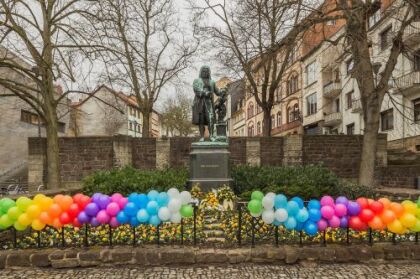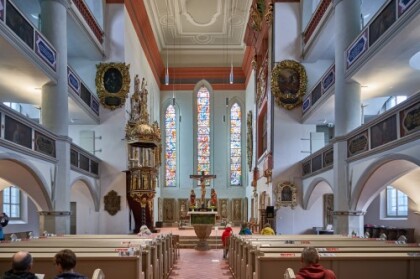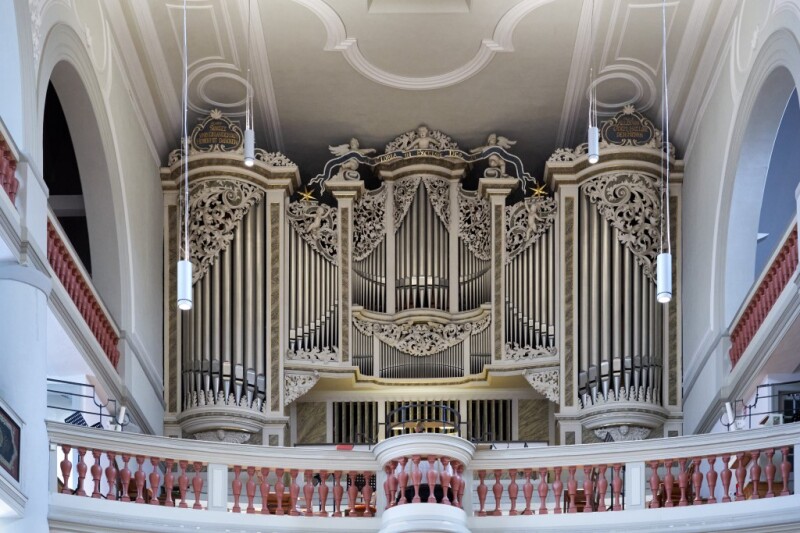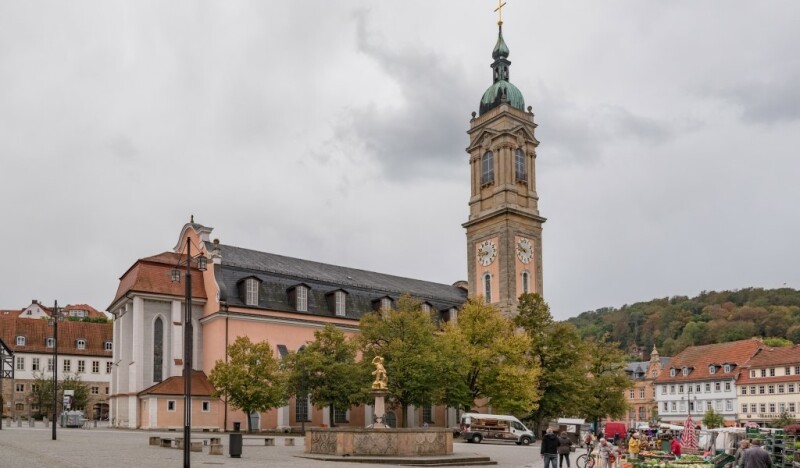St. George's Church: Interesting facts about Bach's baptismal place - History, Architecture & Events
Inhalt
The St. George's Church in Eisenach is not only an architectural highlight of the city but also a living testimony of history and is considered one of the oldest Protestant churches. Its fascinating hybrid architecture, spanning several centuries of new construction, alterations, and renovations, tells the story of the city itself.
This remarkable building, with its roots in the 12th century, has not only undergone countless architectural metamorphoses but has also witnessed important historical events. From the wedding of Saint Elizabeth to the singing and preaching of Martin Luther, to the baptism of Johann Sebastian Bach and the music of Telemann, St. George's Church not only shapes the silhouette of Eisenach but also its cultural and spiritual landscape.
Here, centuries of city history come together in the center of Eisenach.
Why St. George's Church is a Must-Visit in Eisenach
- City and main church of Eisenach: Centrally located on the market square and closely connected to the city's history like few other buildings, St. George's Church is also one of the historical focal points of life in Eisenach.
- Hybrid architecture: Built on the Romanesque foundations of the 12th century, today it stands as a Gothic hall church, with a baroque organ prospect inside and a neo-baroque bell tower outside, which houses 5 bells, the oldest of which dates back to 1585.
- Historical figures: With the Bach seal and memorial, Luther rose, figure grave slabs of the Landgraves, and magnificent coffins of the Dukes of Saxony-Eisenach, St. George's Church connects centuries of significant figures of history in one place.
- Birthplace of Bach's music and Telemann concerts: For over 130 years, organists from the Bach family served here. Johann Sebastian Bach was baptized here, sang in the "Chorus musicus" of his Latin school, and encountered church and organ music for the first time. From 1708, Georg Philipp Telemann led the church music of St. George's Church, composed over 60 cantatas, serenades, church music, and operettas in Eisenach - and got to know the Bach family.
- Events beyond worship: With concerts and participation in the Bach weeks and music festivals, St. George's Church is more than just a place of worship or historical object in the Eisenach cultural scene.
Where Johann Sebastian Bach was baptized
In the already historical walls of St. George's Church, Johann Sebastian Bach received the sacrament of baptism just two days after his birth, on March 23, 1685 (according to the Julian calendar) or April 2, 1685 (according to the Gregorian calendar). The ceremony took place at the late Gothic baptismal font of 1503, which still serves its purpose today, marking just the beginning of the connection between St. George's Church and the work of the musician.
It is very likely that Bach was part of the "Chorus musicus" of his Latin school during his childhood, which repeatedly led him to the halls of St. George's Church. Here, where his first cousin once removed Johann Christoph Bach served as organist, he likely gained his first lasting impressions of church and organ music, probably not least due to the impressively always in need of repair organ of this church.

© NoRud
In the schools and churches, and therefore also by Johann Sebastian Bach, the Eisenach hymn book edition of 1673 was used at that time. Even the former interior view of St. George's Church is depicted on it. The copperplate engraving for this was made by Johann David Herlicius, to whom the only painting of Bach's father, Johann Ambrosius, is also attributed.
The connection of the Bach family with St. George's Church extended over a total of 130 years. Four members of the family, starting with Johann Christoph Bach and ending with Johann Georg Bach, served here as organists from 1665 to 1797 and significantly influenced the musical landscape of the church.
Today, elements in the church remind of the Bach family: The left entrance gate, designed according to the Bach seal, and the Bach monument by the sculptor Paul Birr in the anteroom of the church. The monument replaced the original, more authentic Bach monument by Adolf von Donndorf (which is now located at the Bach House) in 1939 and depicts Bach in a less musical context and based on a dubious depiction of Bach.
Decoding the architecture of St. George's Church
St. George's Church in Eisenach presents today a unique architectural mosaic from various centuries. First mentioned in 1196, the church stands in its basic form as a Gothic hall church in the center of Eisenach. But the history of this building is a kaleidoscope of alterations and changes that have made it what it is today.

© Jean-Christophe BENOIST
Its origin lies in a legend about the lost banner of Saint George, which allegedly inspired the construction of this church. The original Romanesque structures from the 12th century have been preserved, upon which a Gothic-style building developed over the centuries. From 1515, alterations began that fundamentally changed the appearance of the church, which shortly thereafter, however, could not be used for decades due to the strong damages and plundering following the Peasants' War after 1525.
In the following centuries, several renovations and further alterations shaped the appearance of St. George's Church. In the 17th, 18th, and 19th centuries, adjustments were made that made it a mixture of different architectural epochs. Examples include the richly decorated pulpit from 1676 and the baroque organ prospect from 1719.
The 62-meter-high neo-baroque tower, which was added to the previously towerless church from 1899 to 1902, was modeled after the style of the Monza Cathedral and now houses a chime of 5 bells, with the Sunday bell depicting a relief of St. George.
After extensive restoration work in the late 1970s, the church shines again in its historical variety of colors. Another comprehensive renovation project took place from 2011 to 2014 and exposed the original Romanesque foundations.
The crowning touch in the restoration of St. George's Church is the Old Testament Bible verses in the original Hebrew. These took their place on the galleries again in 2019 after they had been "painted over" in 1940.
The current organ of St. George's Church was built in 1982 by the organ building company Alexander Schuke (Potsdam), replacing the former work by Jehmlich Orgelbau Dresden from 1911. The prospect still comes from the organ built between 1697 and 1707 by Georg Christoph Stertzing according to a disposition proposal by Johann Christoph Bach and was then the largest organ in Thuringia.

© Jean-Christophe BENOIST
Current use of St. George's Church: Services & Events
St. George's Church is not only a historical landmark and place of worship today but also a vibrant venue for various events that enrich the cultural life of the city of Eisenach.
Thus, the church not only hosts Sunday services but also participates in more contemporary, secular events, making it also part of Eisenach's modern cultural landscape.
For example, during the Thuringian Bach Weeks 2024, for which Eisenach and St. George's are of course predestined as venues, alongside the Eisenach Bach Choir and Thuringian Bach Collegium from Arnstadt, the ensemble of Café Zimmermann from the Grand Théâtre de Provence in Aix-en-Provence, France, and the Belgian vocal ensemble Vox Luminis contributed musically with their programs and interpretations of Bach's music.
Even at less historically anchored events like the StreetLife Festival, the church participates without straying too far from its core brand. At this music festival with over 60 artists on 15 stages in the city center, there were also gospel, spiritual, and pop music performances in St. George's Church until late at night.
The portfolio of events in and with St. George's is rounded off by further concerts, such as the Sunday concerts with chamber music in 2024, as well as festive and special services.
Regular services take place in St. George's Church on Sundays and public holidays at 10 a.m.
How to get to St. George's Church by car, bus & train
Located directly on the market square in the center of the city and surrounded by other landmarks such as the City Palace, Luther House, and cinema, St. George's Church is hard to miss in the city center.
Arriving by train or bus in the city, your path leads you past the "gateway to the city" through the Nikolaitor, via Karlsplatz and Karlsstraße within about 13 minutes straight to the town church - unless you turn off into the restaurants or shops along the way.
If you arrive by car, going west from Erfurt, you take the Eisenach-East exit and Bundesstraßen B84 and B19 to the city center. Coming from the Eisenach-West exit, you first take the B19, then the B84, and finally the Rennbahn and Clemdastraße, alternatively a little further again via the B19, to the center.
When arriving by car, you should also plan a few minutes on foot and have some change with you. The parking facilities in the city center are all chargeable, except for a few and unlikely, but for example in the parking garage "Am Markt" in the immediate vicinity and are provided there as well as for example at Theaterplatz or at the station with charging facilities for electric cars. Parking fees here range from about €2 to €6 per day.
Cover photo: Tilman2007

 DE
DE 

Questions & Comments
or post as a guest